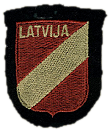A10 305 336
THE RESPONDENT'S TESTIMONY
The respondent testified that he was born on July 23, 1905, at Vircava, Latvia; therefore, on July 1941 he was almost 36 years old. He graduated from High School in Jelgava, Latvia, in June 1923 soon after Latvia became independent (Tr. p. 10201). In March of 1926 he began serving in the Latvian army. He entered Latvian Military Academy in October of 1929 and graduated in September 1931 as a Second Lieutenant (Tr. p. 10212). In March of 1937 he entered the Latvian Army General Staff Academy from which he graduated in December 29, 1939 (Tr. p. 10223). Thereafter he served in the Latvian army headquarters as education department head until September 18, 1940 when he was discharged from the Latvian army which was being demobilized by the Soviets (Tr. p. 1022-10284). On December 18, 1940 he began working in the sugar industry where he worked until May 1941 when he became an Inspector for military and sports education for Industrial schools (Tr. p. 10235). He remained at that job until June 25, 1941 when he was arrested at his office by the N.K.V.D., the Soviet Security Police (Tr. p. 10246). 3/
He testified that the war broke out on June 22, 1941 and he was arrested three days later at his office, and was detained in the central prison in Riga where he received a prison haircut with his head shaved (Tr. p. 1025-10267). On June 30, 1941 he managed to break out of the prison and went to stay with some relatives who hid him in their coal cellar overnight (Tr. p. 10268). On July 1, 1941 when the Germans troops entered Riga, he reported to the Latvian Command Center around noon. He was assigned to command a unit of about 200 men who were sent to Vidzemes Beach to round up retreating Russians (Tr. p. 1027-10289). He was then dressed in civilian clothes, the same that he had on when he got out of prison. All soldiers were armed with rifles (Tr. p. 102810). He returned to Riga in the late afternoon of July 5, 1941 and went to his home at Bierini, which was a suburb of Riga. He slept all day on July 6 and on July 7 put on his Latvian captain's uniform and reported to the self-government headquarters located at the Latvian Society Building on Merkel Street in Riga, which was later located on Annas Street (Tr. p. 102911). The uniform had white trim and was different from the regular army uniform which had red trim. According to the respondent, there were no more than four or five of those
| 3/ | An article detailing the respondent's arrest was introduced by stipulation, along with a translation on November 30, 1978. |
12
| 1 | Testimony of Vilis A. Hazners, 8-March-1978, direct, transcript pp. 1019–1059. |
| 2 | Testimony of Vilis A. Hazners, 8-March-1978, direct, transcript pp. 1019–1059. |
| 3 | Testimony of Vilis A. Hazners, 8-March-1978, direct, transcript pp. 1019–1059. |
| 4 | Testimony of Vilis A. Hazners, 8-March-1978, direct, transcript pp. 1019–1059. |
| 5 | Testimony of Vilis A. Hazners, 8-March-1978, direct, transcript pp. 1019–1059. |
| 6 | Testimony of Vilis A. Hazners, 8-March-1978, direct, transcript pp. 1019–1059. |
| 7 | Testimony of Vilis A. Hazners, 8-March-1978, direct, transcript pp. 1019–1059. |
| 8 | Testimony of Vilis A. Hazners, 8-March-1978, direct, transcript pp. 1019–1059. |
| 9 | Testimony of Vilis A. Hazners, 8-March-1978, direct, transcript pp. 1019–1059. |
| 10 | Testimony of Vilis A. Hazners, 8-March-1978, direct, transcript pp. 1019–1059. |
| 11 | Testimony of Vilis A. Hazners, 8-March-1978, direct, transcript pp. 1019–1059. |
